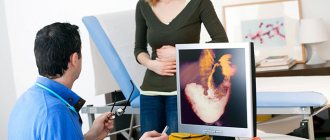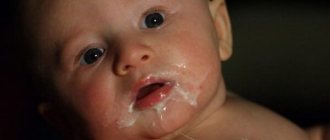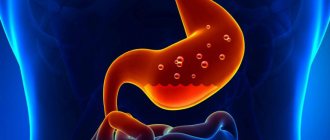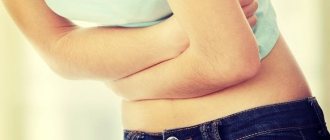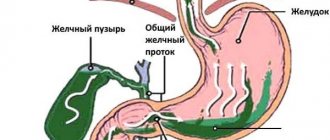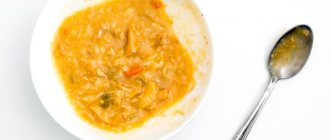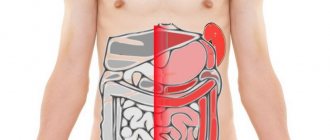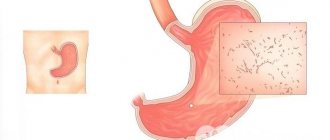Table of contents
What is reflux esophagitis in adults
? Causes
Classification
Non-erosive forms of pathology
Erosive forms
Symptoms of reflux esophagitis in adults
Cough
Extrasystoles
Symptoms of chronic forms of reflux esophagitis
Degrees of reflux esophagitis
Diagnostic methods
Reflux esophagitis and drug treatment with drugs
Lifestyle with reflux esophagitis
Surgical treatment
Is reflux esophagitis dangerous?
Effective traditional medicine for the treatment of reflux esophagitis
Mineral waters for reflux esophagitis
"Borjomi"
"Essentuki No. 4"
Is it possible to cure reflux esophagitis forever?
https://youtu.be/c2qXfoUOfZA
Treatment
Treatment is prescribed by a doctor based on symptoms and diagnosis. It involves the use of medications, herbs and diet.
Drug treatment
Treatment with tablets is prescribed by a specialist. The list of medications that help with esophagitis includes antispasmodics, antacids, antifungal and enveloping medications.
Antispasmodics help relieve abdominal pain - relax muscles, relieve spasms.
Antacids are used to neutralize the increased acidity associated with reflux.
Enveloping drugs act as painkillers - they reduce the sensitivity of nerve endings.
Antifungal medications speak for themselves. Their purpose does not require explanation.
Diet
Diet is the main component in the treatment of esophagitis. After all, it's all about nutrition. In order to know what to eat for reflux, it is worth knowing why it occurs in the first place. Consumption of sour fruits, juices, strong drinks, spicy, smoked foods - this decides the further fate of the disease.
The menu will have to be changed due to painful symptoms. The diet of a patient with reflux should consist of the following components:
- For meat, you can eat lean chicken or other meat with a small percentage of fat.
- Lean fish.
- Still mineral water.
- Fruits and vegetables are fresh, non-acidic.
- Milk, dairy products with low fat content.
- Kissel, jelly.
- Flour products are not fresh, second-day.
- Any cereals.
After eating, the patient should not lie down in a horizontal position for at least 2 hours. Last meal three hours before going to bed.
Description
Catarrhal reflux esophagitis differs in that the surface cells of the mucous membrane of the esophagus become inflamed. Deeper tissues are not affected. If the patient immediately begins treatment for the disease, it will have a favorable outcome. If the patient practices self-medication, taking any medications uncontrollably, he may develop erosive esophagitis.
How do the manifestations of catarrhal reflux esophagitis differ and what is it? Under the influence of unfavorable factors (most often irritation of the mucous membrane), damage to epithelial cells occurs. To restore them, the body mobilizes its forces to increase the activity of leukocytes. If they accumulate in one place, then infiltration can be observed.
The activity of leukocytes leads to the release of mediators of the inflammatory process at the site of their accumulation. This increases the permeability of the vascular walls. Inflammation develops, and under the influence of prostaglandins, a person also feels pain.
The disease of any severity develops most often in the male half of the population due to the tendency to smoke and drink alcoholic beverages.
There are the following degrees of the disease:
- 1st degree - the appearance of minor localized lesions;
- 2 degrees - the presence of small areas of inflammation that gradually merge;
- 3 degrees - inflammation of a significant part of the esophageal mucosa;
- 4 degrees - damage to more than ¾ of the organ. Signs of chronic ulcers and esophageal stricture appear against the background of an extensive disease process.
Distal reflux esophagitis develops against the background of constant irritation of the esophagus. Gradually, the tissues of the organ located closer to the stomach begin to become inflamed, swelling and hyperemia of the mucous membrane appears.
A feature of the disease is the duration of its course, with the initial stages rarely manifesting symptoms. As a result, chronic distal esophagitis develops, which is difficult to treat and often recurs.
The main cause of distal inflammation of the esophagus is insufficiency of the cardia - the circular muscle that blocks the entrance to the stomach. If the sphincter does not close tightly, acidic gastric contents enter the lower esophagus and irritate the mucous membrane, causing severe inflammation.
Often the cause of distal GERD is gastrointestinal diseases accompanied by increased acidity in the stomach, such as gastritis.
Basic treatment methods
Distal esophagitis can be cured with complex therapy:
- taking medications;
- maintaining proper nutrition;
- traditional medicine.
Treatment of pathology is aimed at eliminating symptomatic signs and the causes of the disease. To completely get rid of distal esophagitis at the first stage, long-term therapy is required.
Drug treatment
The prescription of medications depends on the cause of the pathology. The main means are:
- antibiotics – entry of pathogenic bacteria;
- autoimmune – penetration of viruses;
- prokinetics - impaired motor function of the esophagus;
- antacids – increased level of acidity;
- enveloping drugs – inflammation of the esophageal mucosa;
- painkillers – presence of spasms.
The main functions of taking medications are to protect the mucous membrane from the effects of aggressive factors, normalize acidity levels, and eliminate pain. The duration of taking medications is from 4 to 6 weeks.
Proper nutrition
Diet is the main method of treatment for pathologies of the gastrointestinal tract. The basic principles of healthy eating are:
- fractional meals (at least 5 times a day);
- small portions (no more than 200 g);
- prolonged chewing of food;
- inclusion of cereals, broths, soups in the diet;
- refusal of spicy, salty, solid foods;
- maintaining the temperature of food;
- drinking water (at least 2 liters).
It is recommended to consume liquid, crushed food for several weeks. During treatment, you must give up alcohol, tobacco products, and carbonated drinks.
.
The main ingredients of the diet are stewed, baked, boiled lean meats, low-fat dairy products, bananas, peaches, and cereals. After eating, it is advisable not to take a horizontal position for half an hour to avoid gastric juice from entering the esophagus.
ethnoscience
Traditional medicine methods are suitable for eliminating the symptoms of the disease - heartburn, pain. Effective methods are herbal infusions, decoctions of calendula, calamus, anise, lemon balm, and licorice. Potato juice, dill water, tea made from mint, chamomile, blackberry and raspberry leaves help get rid of heartburn. Aloe and sea buckthorn oil have enveloping and protective effects.
To avoid recurrence of the pathology and an attack of chronic distal reflux esophagitis, it is necessary to control the diet, give up bad habits, promptly treat viral and infectious diseases, and undergo regular examinations.
We recommend: What is a Shatsky ring in the esophagus and how to treat it?
Symptoms of reflux esophagitis in adults
Reflux esophagitis is an inflammatory disease of the tunicae mucosae (mucous membrane) of the distal esophagus, which is caused by exposure to gastric or duodenal peptic reflux. The distal section is the part of the esophagus that is adjacent to the stomach. See Structure of the esophagus.
Manifestations in adults include esophageal (heartburn, belching, dysphagia, retrosternal pain and burning, lump in the throat) and extraesophageal (dry cough, hoarseness, pain in the tongue, bitterness in the mouth) symptoms.
Rarely, the disease occurs with moderate symptoms or is completely asymptomatic. More often, the symptoms of reflux esophagitis in adults are pronounced. Symptoms from the esophagus and symptoms from neighboring organs are distinguished.
Symptoms from the esophagus:
- heartburn;
- belching
- pain in the retrosternal region (“tightens behind the sternum”), often radiating to the neck and back, relieved with antacids;
- dysphagia, of varying severity, of a transient nature;
- with a severe illness, vomiting with blood is possible.
Symptoms from other systems and organs:
- from the cardiac system: extrasystoles, conduction disturbances, cardialgia;
- from the pulmonary system: dry cough (sputum appears when a secondary infection is attached), shortness of breath, difficulty breathing, sleep apnea;
- from the otorhinolaryngological organs: symptoms of pharyngitis (pain and mucus in the throat, possible redness of the throat), the appearance of symptoms of acute laryngitis due to reflux disease (hoarseness, severe pain when swallowing, sore throat);
- from the dental organs: phenomena of glossitis (feeling that the tongue is burning, pain in the tongue), damage to tooth enamel, stomatitis;
- from the blood: symptoms of anemia.
Cough
The cough with reflux esophagitis is dry, often painful. Drip infections that occur against this background are severe and can be complicated by the development of bronchial asthma.
There are two mechanisms for the development of cough syndrome:
- Reflux particles, with severe damage to the esophagus, enter the pharynx, and from there into the nasopharynx and trachea, where they irritate the cough receptors of the mucous membrane.
- If the reflux rate is low, and the process is localized only in the distal esophagus, irritation of the vagal centers located in the lower part of the esophagus, which activate the cough center of the brain, is possible.
In order to properly treat cough with reflux esophagitis, it is necessary, first of all, to increase the pH of gastric juice in order to remove the cause that causes it (antacids, IGRs, PPIs). Frequent aspiration pneumonia requires surgical treatment. To make it easier to endure attacks, you can take cough remedies recommended by alternative medicine (honey, aloe, propolis). Breathing exercises are often used.
Extrasystoles
Extrasystole (extraordinary contractions of the heart muscle) is a common complaint in diseases of the stomach and gastrointestinal tract in general. Extrasystoles arise as a result of viscerocardial reflexes and are functional in nature. Special antiarrhythmic treatment is not required, especially with moderately severe extrasystole.
Another reason for the occurrence of extrasystole is the long-term effect of reflux on the vagal centers located in the lower part of the esophagus. The consequence is the development of vegetative-vascular dystonia with psychosomatic manifestations.
Treatment should be aimed at eliminating the pathology that caused the extrasystole.
When patients do not tolerate extrasystole well, especially if it is accompanied by increased excitability (fear, insomnia), of course, correction of the condition is required. But before treating extrasystole, consultation with a neuropsychiatrist is necessary, since substances usually prescribed for neuroses (antidepressants, tranquilizers, antipsychotics) can worsen the condition of the lower esophageal sphincter.
Description of the disease
Reflux esophagitis of the 1st degree is a rather complex disease caused by dysfunction of the closing functions of the esophageal lower sphincter, after which inflammation of the organ mucosa occurs. The pathology begins due to obesity or wearing tight clothing that compresses the esophagus.
The main provocateur of the disease is weakening of the neuromuscular esophageal region. Children suffer the most from this pathology. Also reasons are:
- Strong internal pressure from the stomach suppresses the functioning of the gastrointestinal tract. Because of this, gastritis or peptic ulcer occurs.
- Stressful situations suppress intestinal motility.
- Poor nutrition provokes pathology. Excessive consumption of sweets leads to esophageal diseases.
- Uncontrolled use of medications containing prostaglandins or nitrites as ingredients.
- Smoking is a significant provocateur of reflux esophagitis.
The classification of GERD is as follows:
- In grade 1, the area of damage to the esophageal mucosa is small and limited by folds.
- Reflux esophagitis of the 2nd degree is characterized by the presence of several defects or one, but exceeding 5 mm in diameter. All of them are limited by folds.
- The third degree of pathology is characterized by the presence of several lesions, with up to 75% of the surface of the esophagus affected.
- In the fourth degree of the disease, the prevalence of defects exceeds 75% of the esophageal circumference of the esophagus.
- Grade 5 reflux esophagitis was not detected.
In the first stage of reflux esophagitis, the following clinical symptoms occur:
- The entire esophagus seems to be subject to a burning sensation.
- A person often regurgitates stomach contents or air. The belching tastes acidic.
- There is an unpleasant odor in the mouth.
- Diseases often appear inside the oral cavity.
- The patient feels pain and some burning behind the sternum. Sometimes these signs appear on the left.
Signs of chronic gastroesophageal disease:
- Boring cough. This cough rarely causes mucus to be coughed up.
- The voice becomes hoarse.
- There is a constant lump in my throat.
- The headache is concentrated on the surface of the face.
- The nose is often stuffy.
The severity of symptoms is not always comparable to the stages of the disease.
Causes of distal esophagitis
What is distal esophagitis? In this case, damage occurs to the distal part of the esophagus - the one that is directly adjacent to the stomach. Distal catarrhal esophagitis is characterized by the following manifestations:
- sharp discomfort in the esophagus, stomach;
- choking cough;
- vomit;
- severe burning behind the sternum;
- decreased mood, irritability;
- general weakness.
Such signs of distal catarrhal reflux esophagitis worsen when the patient assumes a supine position.
Sometimes distal esophagitis occurs with repeated insufficiency of the cardia due to the reflux of acidic gastric contents.
Provoking factors for the development of distal esophagitis:
- Repeated reflux from the stomach into the lumen of the esophagus.
- Infectious lesions: fungal (candida), herpes (HSV-1 or HSV-2), bacterial infections.
- Damage from chemicals (alkalis, acids, solvents). Erosive esophagitis occurs.
But the most common cause of the development of distal inflammation of the esophagus is insufficiency of the orbicularis muscle (loose closure between the esophagus and stomach). The process occurs in a chronic form and is aggravated by:
- Diaphragmatic hernia of the esophagus, which provokes a sharp jump in intra-abdominal pressure, due to which part of the cardiac part of the stomach penetrates into the chest cavity. In this case, compressed food masses enter the esophagus.
- Obesity, when a person bends over sharply after eating or overeating, which causes an increase in pressure inside the organs, which is released by expanding the sphincter.
- Abuse of products (coffee, mint chewing gums) or medications (relaxants) that cause relaxation of the esophageal muscles.
- Increased tone of the second sphincter in the pyloric zone of the stomach. As a result of spasm, the acidic contents pour out in the direction of less resistance, provoking distal esophagitis.
Causes of the disease
This diagnosis has been made more and more often by specialists in recent years. It is the increasing prevalence of this type of disease that influences the increasing questions about why distal esophagitis develops, what kind of pathology it is and what treatment methods should be used to completely get rid of it.
First of all, you should find out what can trigger the appearance of this type of inflammatory pathology of the esophagus in a person. As experts note, there are several unfavorable factors that can cause the development of this type of disease:
- the body's response to the aggressive effects of an allergen;
- mechanical injury to the esophageal tube, most often occurring after accidental or intentional swallowing of an object with fairly sharp edges;
- burn of the mucous membrane of a chemical or thermal nature;
- negative effects of certain medications;
- benign or malignant neoplasms in the esophagus;
- long-term progression of infectious diseases such as diphtheria, influenza, scarlet fever and other similar pathologies.
In addition to the above factors, the appearance of inflammatory pathology at the junction of the esophageal tube with the stomach is also greatly influenced by diseases of the gastrointestinal tract such as diaphragmatic hernia, gastritis or ulcer.
Main risk groups
Patients often ask gastroenterologists about distal esophagitis, what kind of disease it is, and who gets it. Leading experts are trying to provide more complete information about this disease, since many people are at risk for its development. It is they who, first of all, should more closely monitor the possible appearance of negative symptoms, indicating the development of this type of disease.
The most dangerous risk factors are:
- tendency to such harmful habits as alcohol abuse and smoking;
- disturbances in the functioning of the immune system;
- overeating, especially in the evening and frequent consumption of too hot or cold, as well as spicy foods.
Those people who work in hazardous industries or live in areas with unfavorable environmental conditions are also at risk. Among young patients, this disease is most often diagnosed in allergy-dependent children. A dangerous disease such as bronchial asthma may have a direct influence on its development.
Types of disease
Highlight:
- distal catal esophagitis;
- distal erosive esophagitis;
- chronic inflammation of the distal part of the esophagus;
each of these forms of the disease has its own special symptoms and approach to treatment.
Classification
According to the localization of erosive foci, they are distinguished:
- distal esophagitis is a common type of injury in which erosions are located in the lower esophagus;
- proximal esophagitis - damage to the mucous membrane of the upper sections;
- total esophagitis - ulcers spread along the entire length of the esophagus.
Depending on the coverage of the circumference of the esophagus by the erosive process, esophagitis is diagnosed in 4 degrees:
- 1st degree - single erosion no more than 5 mm in size, the pathological process is limited to the nearest folds;
- 2 degrees - single or multiple ulcers with a diameter of more than 55 mm;
- 3 degrees - damage to less than 75% of the circumference of the lumen of the esophagus;
- Grade 4 - large or multiple small lesions covering more than 75% of the circumference of the esophagus.
RE has two main forms – acute and chronic.
The causes of acute reflux esophagitis can be:
- allergic diseases;
- exacerbation of chronic stomach diseases (condition after gastrectomy, hiatal hernia, subatrophic gastritis, gastric ulcer);
- infection (candidiasis, septic esophagitis).
Acute reflux esophagitis is manifested by the following symptoms:
- general malaise;
- increased temperature;
- dysphagia;
- heartburn;
- belching;
- pain along the esophagus while eating.
Chronic reflux esophagitis can develop as an outcome of a poorly treated acute form, or as a primary chronic disease. This form of the disease is often accompanied by gastrointestinal diseases; it is characterized by both esophageal and extraesophageal symptoms of EC.
- Depending on the prevalence of the pathological process, they are distinguished: focal reflux esophagitis - the pathological process occupies one or several lesions on the posterior or lateral wall of the organ in the distal (adjacent to the stomach) section;
- diffuse RE - the pathological process occupies all or most of the organ.
Depending on the depth of the lesion, the walls are distinguished: non-erosive reflux esophagitis (superficial) and erosive.
Types and forms
Today in medicine there is no clear generally accepted classification of this disease. However, doctors distinguish between some types based on the duration of its course, as well as symptoms.
Kinds:
- surface;
- erosive;
- erythematous;
The form of the course can be acute or chronic.
Erosive distal esophagitis usually occurs acutely. It usually occurs against the background of certain infections and allergies. This type of disease is characterized by the formation of hemorrhages, erosions on the mucous membrane, as well as increased mucus production.
Distal superficial esophagitis is also called catarrhal. The course of this type of disease is usually chronic. The cause of this type of disease is often a hernia formed at the esophageal diaphragmatic opening.
Erythematous esophagitis is considered a serious type of this pathology . If the exposure of the mucous membrane of the esophagus to the contents of the stomach is short-lived, then foci of inflammation form on it, and the disease proceeds moderately.
In the case of a long-term course of this process, the foci of erosion are connected to each other, forming erythema, which is called erythematous esophagitis. This disease is severe, the affected area occupies a large area, and often bleeds.
Cardia failure
If a patient develops esophagitis, cardia failure occurs quite often. In this case, the valve separating the stomach cavity from the esophagus does not close completely. In this case, damage to the lower third of the esophagus is observed: hydrochloric acid has an aggressive effect on the mucous membrane. Sometimes burns and ulcers appear in this area. The most dangerous complication of esophageal burns is malignant degeneration of erosions.
The most characteristic symptoms of cardia failure are:
- attacks of heartburn that occur regularly in a person;
- nausea, vomiting, feeling of fullness in the stomach;
- abdominal pain;
- decreased performance, apathy;
- weakness.
Treatment consists of following a diet, taking specially prescribed antacids, and maintaining a proper lifestyle.
Respiratory system damage
Reflux esophagitis of the 1st degree can manifest itself in the form of hoarseness, persistent cough, laryngitis, bronchitis, etc. In this case, characteristic symptoms for reflux may not arise at all.
For accurate diagnosis, daily pH measurements are performed. It is used to determine the presence of problems in the respiratory organs. Note that bronchial asthma often appears together with reflux esophagitis. If you ignore this fact, an exacerbation of asthma may occur, which will provoke pneumonia. Then the treatment will be long.
Treatment is carefully selected to eliminate the symptoms of two diseases at once. An active course of medication along with diet therapy has a positive effect on the future prognosis. Also, patients suffering from reflux esophagitis and asthma should permanently give up smoking and alcohol.
Terminal form of the disease
Chronic catarrhal terminal esophagitis sometimes develops in newborns who have suffered oxygen starvation. The manifestations of this disease are dangerous: it is characterized by numerous pinpoint hemorrhages and erosions. Children experience the following symptoms:
- very frequent and severe hiccups;
- vomiting (often gushing);
- poor sleep;
- weight loss.
In adults, the symptoms of this form of pathology are as follows:
- belching (undigested food comes out);
- whitish coating on the tongue;
- vomit;
- severe pain in the abdominal area, worsening when lying down.
Recommendations for mild esophagitis
Using these recommendations, you can cope with reflux esophagitis at the initial stage of the disease:
- Try not to eat too much in one meal. Overeating provokes the release of acid into the esophagus, which causes an attack of esophagitis.
- It is not advisable to eat heavy food before going to bed. It is recommended to limit yourself to a light sandwich.
- You should not drink fatty milk. Drink low-fat milk drinks in small doses. It may seem like relief comes after drinking a glass of milk. A short remission is a new surge of esophagitis.
If you drink full-fat milk with antacids, there is a high risk of developing milk-alkali syndrome.
- Eat only those foods that your doctor has approved. He knows better what's safe.
- Eliminate the consumption of fresh berries at least for a while. You can eat fruit (limited quantity).
- Introduce foods high in fiber and carbohydrates into your regular menu. They eliminate high acidity, and the body accepts such foods more easily.
- Alas, it is worth completely removing fatty and spicy foods from the menu. After several days without fatty and spicy foods, the patient already begins to feel an improvement, since these dishes are difficult to digest in the stomach.
- During the treatment period, you should avoid nicotine. You should also not drink alcohol. These factors only increase the production and then the release of gastric juice.
- You should go to bed no earlier than 3 hours after your last meal.
- Do not prescribe treatment for yourself; this should be done by a specialist.
Types, degrees
Esophagitis can progress to the point of death of esophageal cells.
- Catarrhal or superficial - without morphological changes in the tissues of the organ.
- Edema - with severe hyperemia and swelling of the mucous membrane.
- Erosive - with the appearance of red focal wounds on the walls. Develops as a result of infection with pathogenic microorganisms and certain irritating substances. If fibrin formation is added to erosions, fibrinous esophagitis develops.
- Hemorrhagic - with large-scale damage to the lining of the esophagus by hemorrhages. Occurs when the body is infected with viruses, for example, influenza, typhus.
- Pseudomembranous and exfoliative - the result of diphtheria or scarlet fever.
- Necrotic - with tissue death. Occurs during the complicated course of infectious diseases.
- Phlegmonous - with mechanical damage to the mucous and submucosal layers.
- Allergic GERD, which occurs with asthma and other respiratory tract lesions.
- Occupational GERD, which appears when workers in production exhale vapors of harmful substances (acids, alkalis, organics).
Rare types of the disease include dysmetabolic and granulomatous esophagitis.
More often, distal reflux esophagitis develops with repeated cycles of cardia insufficiency and appears against the background of exposure to acidic contents from the stomach on the esophagus. According to the nature of the lesions, this disease can be:
- superficial, non-erosive;
- ulcerative with foci of necrosis throughout the entire thickness of the mucosa;
- with damage to the submucosal layers to deep defects, causing thinning of tissues and perforation of the esophageal wall with bleeding.
According to the severity of morphological changes, distal reflux esophagitis develops with the following degrees of severity:
- 1st degree - mild focal redness of the mucous membrane. The structure of the mucosa at the junction with the stomach is loose, with smoothed folds.
- 2nd - single or multiple erosions of an elongated shape with the possible formation of exudate. Wounds appear predominantly in the folds of the mucosa and affect no more than 10% of the entire distal esophagus.
- 3rd - numerous merged erosions, covered with exudate and necrotic tissue. The affected area is more than 50%.
- 4th - merged erosions are located in a circle, severe exudative-necrotic damage is noted. Severe fibrinous lesion covers the entire area 5 cm above the cardia.
During the pathology, 4 degrees of severity are distinguished.
Treatment of esophagitis
There are many treatment options for esophagitis, but it is worth remembering that you can eliminate some symptoms yourself, and for certain types of esophagitis (described above), an appointment with a gastroenterologist or hospitalization is necessary. To cure esophagitis, you can take the following steps:
- Reduce the level of acidity and salts in the blood. For this purpose, there are various drugs called antacids. They should be prescribed exclusively by the attending physician!
- Chronic distal reflux esophagitis requires long-term treatment, therefore, for this type of disease, medications are prescribed to protect the walls of the esophagus and their mucous membrane. These drugs are called alginates
- Various antibiotics and hormonal drugs are used to relieve inflammation.
- Distal catarrhal esophagitis, as the simplest type of disease, is much easier to treat. It uses decoctions of various herbs and plants, for example sea buckthorn.
- And the main thing, of course, is prevention. A diet for patients with esophagitis is prescribed both during treatment and after it. To fully understand the menu you need, consult your doctor.
At all times, human health has been considered the main value in life. Indeed, virtually everything depends on the state of health. And such little things as the mood at one time or another, whether the day will be productive or vice versa, and such global things as getting an education, choosing a profession, life path. After all, you see, our choice largely depends on our capabilities, and if these capabilities are limited, then, accordingly, the variations in the choice of certain things also decrease.
And in the twenty-first century, unfortunately, there is no need to talk about completely healthy people. Modern ecology, sedentary or, on the contrary, too restless rhythm of life, unhealthy diet - all this worsens health, makes you weaker, less active, and so on. The main thing to remember is that a healthy lifestyle, proper nutrition and a positive attitude will help not only in curing any disease, but also in preventing it.
Lifestyle
Before starting treatment for reflux esophagitis, it is necessary to get rid of those addictions and habits that led to cardia insufficiency. This means that you need to listen to simple recommendations and strictly follow all medical advice:
- Diet therapy is one of the main components in the treatment of gastrointestinal patients. Patients must strictly adhere to the recommended diet, excluding all prohibited foods from the menu. Food should be warm, boiled (or steamed), soft. You need to eat regularly, often, in small portions.
- A patient with EC must avoid physical and mental stress and stressful situations in every possible way. However, you cannot completely give up physical activity (you can visit the pool, go for walks).
- It is necessary to ensure a full 8 hours of sleep at night. It is better to sleep on a special wedge-shaped pillow for GERD, one end of which is raised twenty centimeters above the level of the bed, which prevents the backflow of gastric contents and allows you to sleep correctly.
- Quit alcohol and smoking.
All these tips must be followed even after the clinical manifestations have subsided, so they are a prevention of repeated exacerbations.
Treatment of erosive esophagitis should be combined with adherence to a rational diet and daily routine. If you follow these rules, you can overcome the disease and cope with unpleasant symptoms.
Regardless of the stage of the disease, the patient must follow the following rules:
- meals should be exclusively fractional, and the break between meals should not exceed three hours;
- the last meal should be 3 hours before bedtime;
- fatty, hot, cold foods, fast food, baked goods, sweets are excluded;
- Alcohol, coffee, and sparkling water are prohibited;
- food should be boiled, steamed, stewed, baked;
- a patient diagnosed with erosive distal esophagitis is prohibited from overeating.
Such a person is prohibited from wearing tight underwear or belts. After eating, you should not lie down: you need to take slow walks. You need to sleep on two pillows.
So, catarrhal esophagitis can be effectively treated if it is detected early and consulted with a therapist. In advanced forms of pathology, surgery is necessary. Maintaining a healthy lifestyle will help prevent the occurrence of such a disease.
The formation of erosive and ulcerative foci in the esophagus is provoked by:
- reflux of acidic stomach contents into the esophagus - this process is characterized by reflux esophagitis, hyperacid gastritis and gastric ulcer;
- taking aggressive substances that cause burns to the esophageal mucosa;
- surgical interventions on the chest, examination of the gastrointestinal tract using a probe (fibrogastroduodenoscopy, sampling of gastric juice and bile);
- long-term use of certain medications;
- mechanical damage (fish bone, ingestion of small hard objects);
- various infections (fungal, bacterial, viral);
- allergic reactions;
- congenital malformation of the esophagus in children (usually stenosis of the cardiac part of the stomach).
The occurrence of acute or exacerbation of chronic esophagitis can be provoked by a nervous shock, an error in diet (a festive feast or eating fried/spicy food and, as a result, an increase in stomach acidity), the habit of smoking on an empty stomach and drinking alcohol.
Treatment and prevention
Treatment of esophagitis is complex, complex and lengthy. It is used to eliminate the root cause of the disease and reduce symptoms.
General recommendations
- timely treatment of concomitant gastrointestinal pathologies, for example, gastritis;
- giving up bad habits: drinking alcohol, tobacco;
- refusal to self-medicate any pathologies, even a simple headache;
- wearing loose clothing without tight belts;
- rest after eating in an upright position or sitting;
- avoid frequent bending of the body forward and carrying heavy objects;
- sleep with the headboard raised 15 cm.
Diet therapy and regimen
A balanced diet is the main component of effective treatment of any gastrointestinal pathology, especially distal catarrhal or fibrinous esophagitis.
Basic principles:
- small, frequent meals - up to 7 times a day every 2-3 hours;
- small portions - up to 350 ml;
- chewing thoroughly;
- slow walks after meals;
- enriching the menu with liquid cereals, low-fat soups, sweet fruits;
- refusal of solid, irritating foods, chemically and thermally aggressive products;
- maintaining the temperature of the dish - no higher/lower than 22 °C;
- abundant drinking regime. Water - slightly alkaline, without gas;
- last meal 3 hours before bedtime.
Medicines
For drug treatment of catarrh or another type of GERD, medications are required in accordance with the main causes of the pathology:
- for a bacterial infection, antibiotics are prescribed;
- in case of viral infection - antiviral and immunostimulants;
- when acidity decreases - antacids;
- to stabilize the production of acids in the gastrointestinal tract - histamine blockers and
- proton inhibitors;
- for chronic pathology - alginates to protect the mucosa.
- for severe pain - antispasmodics.
To reduce the factors causing superficial distal esophagitis, a number of antibiotics, hormonal, and anti-inflammatory drugs should be abandoned. GERD can be treated with the following effective drugs:
- "Omeprazole" is an antacid;
- "Motillium" is a prokinetic agent of the second generation.
Diagnostic methods
ER is diagnosed using endoscopy (with biopsy), x-ray examination of the esophagus and stomach, intra-esophageal pH-metry and manometry.
- Esophagoscopy allows you to carefully examine the esophageal mucosa, determine the degree of damage to the organ according to the Los Angeles classification (a, b, c, d), and take a biopsy specimen for histological examination.
- X-ray with contrast of the esophagus allows you to identify the lesion and the degree of narrowing of the lumen of the organ.
- Long-term measurement of esophageal acidity allows us to determine the presence of gastroesophageal reflux.
- Manometry of the esophagus - allows you to evaluate the motility of the organ and determine the clearance of the esophagus.
After the examination, a diagnosis is made and drug treatment is prescribed.
Symptoms and diagnosis
The clinical picture of the pathology is manifested by the following symptoms:
- Heartburn with substernal localization. The burning sensation is aggravated after eating or overeating, during physical activity, or while lying down.
- Belching with a sour or bitter taste in the mouth.
- Increased salivation, especially at night.
- Pain in the chest area, similar to angina pectoris.
- Hoarseness and hoarseness in the voice.
- Quick satiety after eating a small amount of food.
- Cough without sputum.
- Sore throat when swallowing with disruption of the process of swallowing food and liquids.
- Hiccups.
- Bad breath.
Some symptoms decrease or stop after taking antacids. With erosive, necrotic or exfoliative esophagitis, cough and vomiting with rejected areas of esophageal tissue are especially pronounced. Diagnosis of distal esophagitis is based on an analysis of symptoms and the results of a complete examination of the gastrointestinal tract, which includes 6 stages:
- X-ray of the esophagus - to detect the cause of the pathology and determine the cyclicity of reflux when contrast is administered.
- Endoscopy of the esophageal mucosa - to determine the severity of the disease.
- pH-metry inside the esophagus - to calculate the acidity of the environment in the lumen of the organ.
- Determination of esophageal clearance - to calculate the degree of protection of the special mucus produced in the wall of the esophagus. The method allows us to determine the possibility of moving the pH of the lumen medium in the desired direction without causing damage.
- Manometry - to calculate the internal pressure in the gastrointestinal tract, which affects reflux.
- Radionuclide scanning - to clarify the diagnosis.
Reflux esophagitis and drug treatment with drugs
For rational treatment of the disease it is necessary:
- change your lifestyle to eliminate the negative influences that led to the disease;
- take all medications prescribed by your doctor;
- if necessary, supplement drug therapy with traditional medicine.
Drug therapy is prescribed in accordance with the severity of the inflammatory process and the severity of the pathological process. The doctor determines how long and in what dosage to take the tablets.
Pathogenetic drugs are:
- antacids and alginates - drugs increase the pH of gastric juice, thereby reducing acid aggression on the esophageal mucosa, in addition, they envelop the mucosa, providing cytoprotection (cell protection).
- antisecretory agents (IGR, PPI) - reduce the concentration of H ions in gastric juice;
- Prokinetics are drugs that accelerate the movement of food from the stomach into the intestines, thereby eliminating congestion in the stomach and increasing the tone of the lower sphincter.
Diagnostics
The diagnostic process occurs through an integrated approach, which consists of the following stages:
- First of all, radiography is performed. The esophagus is checked for the causes and recurrence of reflux (its cyclical nature).
- Using an endoscope, the esophageal tube is examined to determine the severity of the disease.
- Determination of acidity is a necessary point in diagnosing the disease.
- It is necessary to determine the internal pressure of the organs of the gastrointestinal tract that affect reflux.
- An indicator of the speed of clearing mucus produced by the esophagus.
Based on the listed analyzes and studies, conclusions are drawn and a diagnosis is made. Treatment is prescribed based on the diagnosis.
Surgical treatment
Surgery for reflux esophagitis is a last resort. It is resorted to only if the consequences of refusing the operation are much more severe than the operation itself and the risks of its complications.
Indications for surgical treatment:
- complex drug therapy prescribed in maximum doses, carried out for more than six months, did not produce results;
- the patient has frequent aspiration pneumonia, threatening severe pulmonary pathology;
- severe complications of chronic reflux esophagitis have developed (scar narrowing of the esophagus, severe ulcerative pathology, Barrett's esophagus, bleeding);
- The patient has a hiatal hernia.
Degrees of pathology
The first (“A”) degree of the disease discussed in the article is characterized by the development of hyperemia of the esophageal mucosa and the appearance of local erosions on it. Their diameter usually does not exceed five millimeters. Manifestations of grade A reflux esophagitis are usually absent or mildly expressed. A person usually does not consult a doctor or does so when the disease has progressed to the next stages.
The further course of the pathology looks like this.
- With the second degree, significantly more defective zones are observed, and they begin to merge. They do not cover the entire surface of the esophagus.
- In the third degree of development of the disease, the ulcerative lesion covers a significant part of the esophagus. The symptoms are clearly defined.
- When the fourth stage occurs, almost the entire mucous membrane can be affected. It is difficult for a person to swallow, and the pain is constant and does not depend on food intake.
Note! This stage of the pathology is the most severe and dangerous, because it can cause acute narrowing of the lumen of the esophagus, and sometimes cancer.
Folk remedies
At the initial stage of the disease, folk remedies can cope with unpleasant symptoms, stop inflammatory processes, and normalize acidity levels.
- Herbs . A collection of herbs from chamomile, lemon balm, thyme, and St. John's wort has an excellent therapeutic effect. And also rose hips. The collection is poured with boiled water, left for at least 20 minutes, taken before meals or 20 minutes after meals.
- Sea buckthorn oil . It has a lot of useful properties - anti-inflammatory, analgesic, enveloping, antibacterial, antifungal, wound healing. The oil is taken three times a day, 1 teaspoon on an empty stomach. The duration of therapy depends on the complexity of the disease.
- Flax seeds . An indispensable remedy in the treatment of gastrointestinal diseases. Contains many vitamins and minerals. A decoction of flax seeds acts as an antacid. Protects the esophageal mucosa from irritants and reduces acidity. The raw materials are poured with water, boiled for 2 hours over low heat, and left for 30 minutes. Take 1 tbsp three times a day. spoon. More is possible.
- Aloe juice. One of the best folk remedies. The juice of this plant is a natural antibiotic. Eliminates inflammatory processes, protects against irritation, regulates the number of yeast fungi. Take 1 teaspoon before meals. If there is no live plant in the house, you can buy oil Chlorophyllipt based on aloe. Disadvantage: unpleasant taste.
- Honey _ It has anti-inflammatory, healing, enveloping properties. Regulates acidity. However, this drug must be used with caution. If during therapy, discomfort in the stomach increases or an allergic reaction develops, the product should not be used. In other cases, honey is consumed at a rate of 50 ml per day. Allowed to be added to tea.
- Potato juice . If heartburn is severe, you can use an affordable remedy - fresh potato juice. Acts similar to antacids. Grate the potatoes on a fine grater and squeeze out the juice through cheesecloth. You need to drink 100 ml on an empty stomach.
- Dill seeds . 2 teaspoons of raw material are poured into 200 ml of water, left under a closed lid for half an hour. Take during the day.
- Sunflower seeds . You can get rid of heartburn with sunflower or pumpkin seeds. Just click them, the therapeutic effect will occur within 10 minutes.
It is advisable to take folk remedies at the initial stage of the disease, during the chronic course of the disease, and also as an auxiliary component in the complex therapy of complex forms of distal esophagitis.
For inflammation of the esophagus, dietary nutrition is one of the main components of successful therapy.
- You need to eat small portions up to 6 times a day. Avoid overeating and full stomach.
- Food should be comfort therapy – warm. Cold, hot food irritates the walls of the esophagus, causing heartburn.
- Avoid fatty, fried, spicy foods and canned foods.
- Avoid alcoholic drinks, carbonated drinks, and coffee.
- Dishes should be steamed, baked, boiled.
- It is prohibited to consume sweets and flour products made from yeast dough.
- Be sure to eat soup, broth, porridge, stewed vegetables.
Introduce fermented milk products into your diet - kefir, cottage cheese, homemade yogurt, fermented baked milk. And also hard cheese, porridge - buckwheat, rice, oatmeal. Allowed are mashed potatoes, soup with meat and vegetable broth, boiled fish, eggs, steamed cutlets, dumplings, and pasta. You should refrain from eating legumes, cabbage, fatty meats, and sour fruits. These foods increase acidity. Drinks allowed are still mineral water, dried fruit compote, and green tea.
Which doctor treats distal reflux esophagitis?
When the first symptoms of distal reflux esophagitis appear, you should consult a specialist. Otherwise, the disease may progress to the next stage, in which the area of erosion significantly increases. Treatment is provided by:
At the first appointment, the doctor carefully examines the patient, analyzing existing complaints. To clarify the clinical picture, he asks several questions:
- How long ago did the symptoms appear?
- Do you have other chronic diseases?
- Has the patient suffered esophageal injury?
After the examination, the doctor will prescribe the necessary diagnostics in your case. Some diseases are difficult to diagnose, as they say “by eye”. Therefore, you need to trust your doctor when prescribing tests. After all the tests, the doctor will be able to formulate the correct course of treatment. Remember: accurate diagnosis and correct diagnosis are already 50% of success in treatment!
Treatment methods
Therapy for distal reflux esophagitis is prescribed based on the degree of the disease. It could be:
- Drug treatment;
- Physiotherapy;
- Operation.
Additionally, the patient will need to follow a special diet. You need to eat food at least 5-6 times a day in small portions. You need to exclude carbonated drinks, spicy, fried and fast food from your diet. You should have dinner no later than 3-4 hours before bedtime.
Reasons for the development of the disease
Various factors can cause the disorder, which can be eliminated independently by maintaining proper nutrition or by mandatory use of medications. The main causes of grade 1 reflux esophagitis include:
- the second and third periods of pregnancy, when the fetus compresses the digestive tract and causes spontaneous opening of the sphincter;
- the first period of pregnancy, during which the release of contents occurs due to toxicosis;
Toxicosis provokes the release of gastric juice into the esophagus
Wearing tight clothes is one of the causes of reflux esophagitis
Frequent overeating weakens the sphincter and promotes the reflux of acid into the esophagus
Attention! Often, the process of formation of first-degree reflux esophagitis is triggered by chronic gastrointestinal diseases, including ulcers, gastritis, pancreatitis, and cholelithiasis. They are rarely single and are almost always accompanied by the development of weakness of the sphincter of the esophagus and stomach.
Useful video
It is impossible to cope with the disease without medications. This video offers several remedies that can cope with heartburn - one of the most unpleasant symptoms.
The medicinal part of the treatment of such a disease as chronic distal esophagitis NK stage 2 is prescribed by a doctor and adjusted as the result is achieved. The presence of antacids of the non-absorbable group is required: Almagel , Almagel A , Phosphalugel . They reduce acidity, act for a long time, protecting the mucous membrane from the action of hydrochloric acid.
The complex of drugs includes the mandatory prescription of antispasmodics, for example,
No-shpa , Drotaverine . An integral part are drugs - histamine receptor blockers: the most beloved and effective among them are Famotidine , Ranitidine .
Proton pump blockers reduce the production of active hydrochloric acid - these are Omeprazole , Pantorazole . In parallel with this, assuming the presence of microorganisms, De-nol and Clarithromycin . The treatment regimen is the same as for a stomach infection.
Prokinetics will enhance the insufficient motor activity of the stomach, thereby preventing stagnation and reflux of food into the esophagus - these are Galaton , Motilium . In case of severe pain, local anesthetics – lidocaine and antacids with an anesthetic component – should be used in the first stages.
Surgical treatment is indicated when therapy is insufficient or the disease is complicated by a diaphragmatic hernia or perforation of the esophagus.
General description of grade 1 reflux esophagitis
The human stomach produces hydrochloric acid through its glands to digest food. Since it is useful only when it is in the gastric cavity, there are so-called closing devices in the digestive system, which are sphincters. The stomach contains two - one goes into the cavity of the esophagus, the second into the intestine.
When, under the influence of certain factors, the patient experiences weakness of the first sphincter, some of the acid and products soaked in it begin to exit into the esophagus. The mucous membrane of this section of the intestine always has neutral acidity and begins to suffer due to the slightest exposure. After the first cast, small burns appear on it. With systematic penetration of gastric juice, these erosions do not go away and are chronic.
Stomach acid causes burns to the mucous membranes and discomfort in the throat and chest
With first-degree reflux esophagitis, the burns are small in size, and with timely treatment and a transition to proper nutrition, they disappear. Typically, pathology in the initial stage without further progression occurs during pregnancy due to toxicosis and the growing fetus putting pressure on the gastrointestinal tract.
Attention! Reflux esophagitis of the 1st degree can be temporary and quickly reversible after a slight overeating or vomiting due to poisoning. In this case, the burns go away within a few days and do not become chronic.
Causes
There are a number of factors contributing to the development of distal reflux esophagitis. Among them:
- Reflux from the stomach into the esophagus;
- Infection with bacteria, fungi or viruses;
- Influence of chemicals;
- Damage and trauma to the esophagus;
- Medical manipulations;
- Allergen influence;
- The effect of high temperatures on the walls of the esophagus.
In some cases, the disease develops due to the use of alcohol or certain medications. Distal reflux esophagitis and the appearance of erosions may be preceded by nervous disorders. The situation is aggravated if a person has benign or malignant tumors of the esophagus.
What to do if symptoms appear?
To alleviate the symptoms, you should unload the stomach, switch to fractional meals, give preference to boiled and baked foods, and steamed dishes. Flatulence is promoted by eating poorly prepared food, cabbage, rye bread, legumes and carbonated drinks.
If there is no exacerbation, you can use traditional medicine recipes that will help eliminate discomfort.
It is recommended to exclude or limit as much as possible the consumption of foods that stimulate the production of gastric juice. These include rich broths, smoked and fried dishes.
How to get rid of burning sensation, bloating, stomach pain, bad taste in the mouth, nausea? Both folk and traditional methods of treatment help in different ways: some are faster and more effective, others, on the contrary, take a longer time. The human body is individual, so you cannot be 100% sure that if a product helps one, it will have a positive effect on another.
The regular occurrence of unpleasant symptoms is a reason to visit a specialist. To make a diagnosis, a full examination of the gastrointestinal tract is performed. Afterwards, an adjusted diet and an appropriate treatment regimen are prescribed based on the patient’s medical history and characteristics of the body.
Distal esophagitis is a common disease that occurs against the background of poor nutrition, nervous disorders, poor environment, and alcohol abuse. Often provocateurs are Candida yeast fungi, localized on the walls of the oral cavity, mucous membranes of the genital organs, esophagus, and intestines. The disease is easily treatable if you respond to the problem in a timely manner and take the right measures.
How is the treatment carried out?
Vegetables and fruits are required for esophagitis
Treatment of any esophagitis begins with changing eating habits. In acute stages it will happen by itself, because... you simply cannot swallow sharp food. In chronic esophagitis, treatment with diet is the main principle. No matter what medications you take, the treatment will not be effective if soda, smoked meats and pickled cucumbers are still present in your diet. Look through the recipes for healthy eating - they are not as boring as they seem at first glance.
There are also very simple methods to reduce the activity of the process. Cultivate the habit of not wearing tight clothes, tight belts and excess weight. Do not increase intra-abdominal pressure with these factors. You shouldn’t go to bed after eating to rest. In order for food to properly settle in the stomach and not return to the esophagus through reflux, it is necessary not to take a horizontal position an hour and a half after eating.
Treatment with medications involves the prescription of antacids for chronic processes, antispasmodics and antibiotics if necessary. Sometimes, when complications develop—ulcers, bleeding—surgical treatment is required.
We don't think you like this prospect. So think carefully when you go grocery shopping. And choose foods that won't harm you.
Share with your friends:
What is important to know
The basis of therapy for chronic distal esophagitis is elimination of the cause, which entails the disappearance of irritation and damage to the mucous membrane. Elimination of chemical production factors, bad habits associated with alcohol and smoking, nutrition correction - this is what needs to be done first of all for the success of treatment.
Nutrition should be reviewed as follows:
- Adjust the diet towards low-fat foods , boiled meat, reducing the proportion of carbohydrates and fats. Consume fermented milk products, low-fat cottage cheese, steamed omelettes and boiled vegetables;
- be sure to reconsider your eating regimen: increase the frequency of meals per day to 5–6 times , while the total amount of food should not be increased, but even decreased;
- the temperature of the dishes should be gentle for the damaged mucous membrane of the esophagus: hot and cold dishes , all food should have a temperature no higher than 40–50 degrees Celsius;
- the above dietary requirements remain for the rest of your life with slight relaxations during the period of remission.
The initial form of esophagitis in children and pregnant women
Babies who have not yet learned to talk cannot explain their condition. But unpleasant phenomena for a child can be recognized during and after feeding. The child begins to shirk the spoon with food, often cries and coughs at night. Symptoms in small children differ slightly from the usual signs:
- Dyspnea.
- Nervousness.
- Increased body temperature.
- Restlessness in the evening.
- Prolonged crying.
- Night cough.
- Regurgitation, nausea and vomiting.
- Diarrhea.
If there are two signs from the above list, you should show the child to a pediatrician.
Among other things, a baby diagnosed with reflux esophagitis requires certain care. Since the baby has a spherical stomach, feeding should be done in a semi-vertical position. After eating, do not let your child fall asleep for about 2 hours. The pillow on the bed should be higher than usual (10-15 cm).
Treatment of esophagitis in young children is quite specific, since it is difficult to select a drug due to its possible toxic effect on the child’s body.
In newborn babies, regurgitation in the first three months is considered normal.
Pregnant women can also experience symptoms of reflux esophagitis. This is due to increased intrauterine pressure. Symptoms are usually observed late in pregnancy. As a rule, the condition improves after childbirth.
You can learn about the features and causes of reflux esophagitis from this video:
Reflux esophagitis 1st degree - what is it? The question arises for those to whom the doctor makes this diagnosis for the first time. Reflux esophagitis is inflammation of the lower esophagus as a result of reflux of acidic intestinal contents.
Degrees of the disease
The severity of the disease determines its symptoms. The first 2 stages of the disease do not have clear manifestations, so it is difficult to diagnose the disease. Doctors divide reflux esophagitis into four degrees:
- The initial degree expresses itself as single erosions, slight swelling of the mucous membrane is possible, the surface of the membrane is somewhat loose.
- The second is more obvious: erosions are sporadic, have taken an oblong shape, and are located exclusively on the folds of the lining of the esophagus.
- Third degree - an area of 50 percent is affected, exudates appear, necrosis develops.
- The fourth stage is characterized by narrowing of the esophagus and deep ulcers.



